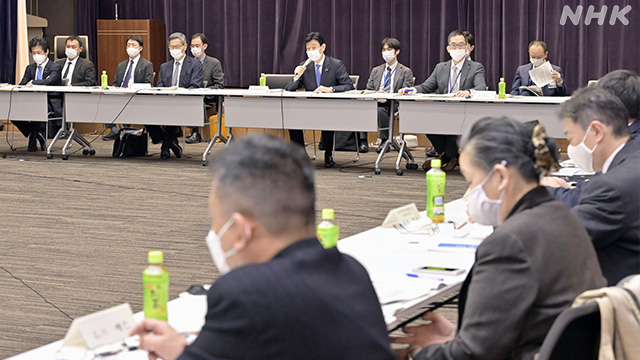According to the proposal made by the government's "Coronavirus Infection Control Subcommittee", the "stage" index for viewing the infection status summarized last year did not work well during the third wave of infection, so the stage We have reviewed some of the indicators for judging.
Dividing the "stage" into four stages according to the infection status is the same as before, but the position of the stage is shown again, and "stage 1" is "the stage where there is no particular problem with the medical care provision system" and "stage 2". "stage the load of the infected persons increasing and the health care provider system is to accumulate", "correspondence is necessary steps to avoid the occurrence of a large obstacle in the rapid increase and health care provision system of the infected person," "stage 3",
"stage "4" is defined as "a stage that requires measures to avoid explosive spread of infection and serious malfunction of the medical care provision system."
In addition, in order to detect early signs of the spread of infection that may lead to a situation that imposes a burden on medical care, as an index for grasping "the rise of infection from a stable situation", "positive persons by onset date" In addition to the "number", "positive rate of PCR test", "speed of infection spread" such as whether the number of newly infected people has increased compared to the previous week, the infection spreads to the elderly starting from the younger generation, so age He says it is necessary to keep an eye on other new trends in the number of infected people and to pay attention to the number of people in the red-light district at night.
In addition, as an index for grasping "the timing when there is a high possibility of reaching stage 4 and strong measures should be taken before that", in addition to "speed of infection spread", the maximum number of beds secured by prefectures is 2 weeks. It is necessary to set and see the number of newly infected people who are expected to reach full capacity in 4 weeks from the beginning.
And basically, it is important to take strong measures at an early stage, including priority measures such as prevention of spread, as a "circuit breaker" to apply a sudden brake when the infection is likely to spread in "Stage 3". In some cases, it is possible to use it from the stage of "Stage 2", and in "Stage 4", measures by declaring an emergency should be considered.
After that, we reviewed the items that had been shown as indicators to judge the stage so far, 1 "Medical tightness", 2 "Number of medical treatments", 3 "Positive rate of PCR test", 4 "Number of newly infected people", 5 It was set to 5 of "Percentage of people whose infection route is unknown".
Among these, as a specific item of "medical tightness", not only the usage rate of beds, but also the number of people who cannot be hospitalized and receive medical treatment at home or institution increases as the number of patients increases. The percentage of people who have been hospitalized has been newly added as the "hospitalization rate".
In addition, the numerical values that serve as a guide for each item are shown. In the case of "Stage 3", the usage rate of secured beds is 20% or more, and the usage rate of secured beds for severe cases is 20% or more. Hospitalization rate is 40% or less, "number of medical treatment" is 20 or more per 100,000, "positive rate of PCR test" is 5% or more, "number of newly infected people" is 15 or more per 100,000 in a week, and "The percentage of people whose infection route is unknown" is 50% or more.
In the case of "Stage 4", the usage rate of secured beds is 50% or more, the usage rate of secured beds for severe cases is 50% or more, the hospitalization rate is 25% or less, and the number of medical treatment persons is "the degree of medical tightness". Is 30 or more per 100,000, "Positive rate of PCR test" is 10% or more, "Number of newly infected people" is 25 or more per 100,000 in a week, and "Percentage of people whose infection route is unknown" It is 50% or more.
Based on this, the national and prefectural governments emphasized indicators related to the status of infection in the early stages of infection spread, and decided to take prompt measures even if all the indicators were not met.
On the contrary, when the infection is settled, the indicators related to the medical system will be given more importance and the mitigation of countermeasures will be carefully judged.
Furthermore, in rural areas, the medical system is fragile and the number of newly infected people is small, and medical pressure is likely to occur. In addition, once the infection spreads, it will reach "Stage 3" in a short period of time, so it will be active even before it reaches "Stage 3". It is said that it is necessary to take measures in a targeted manner.
The subcommittee stated that the prefectural governments should comprehensively and independently judge the stage of this new index as a guide, but the national government will take leadership when there is a high possibility of widespread infection. I asked.
The subcommittee will advise the national and prefectural governments on the stage judgment based on the evaluation of the infection status.

